It looks like you're using an Ad Blocker.
Please white-list or disable AboveTopSecret.com in your ad-blocking tool.
Thank you.
Some features of ATS will be disabled while you continue to use an ad-blocker.
17
share:
I was researching the Villa of Mysteries at Pompeii when i came across a paper which makes a very good case that the winged Deimos seen illustrated
whipping the initiate is a representation of Agnoia, Ignorance, who suddenly appears after the climactic moment of revelation, and is therefore
attempting to force the initiate back into a state of denial and ignorance.
The Mysteries of Dionysos at Pompeii
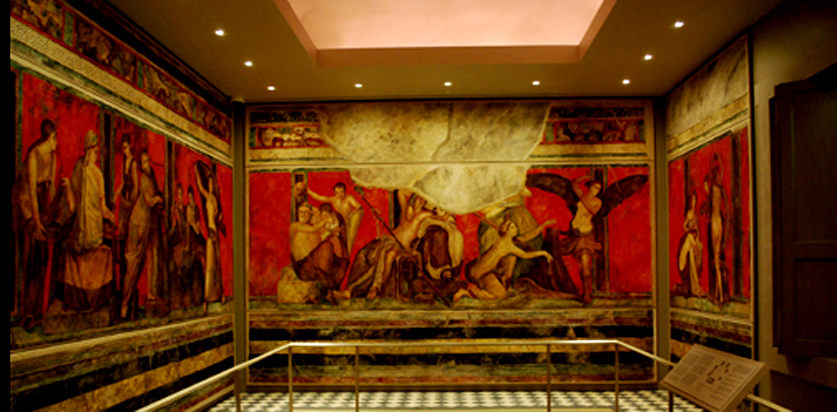
The ten panel sequence as described in the paper begins with the preperation of the initiate through to the ordeal of the revelation and then after the climactic panel her denial of ignorance, ecstatic embrace of the revealed truths and readjustment back into society;
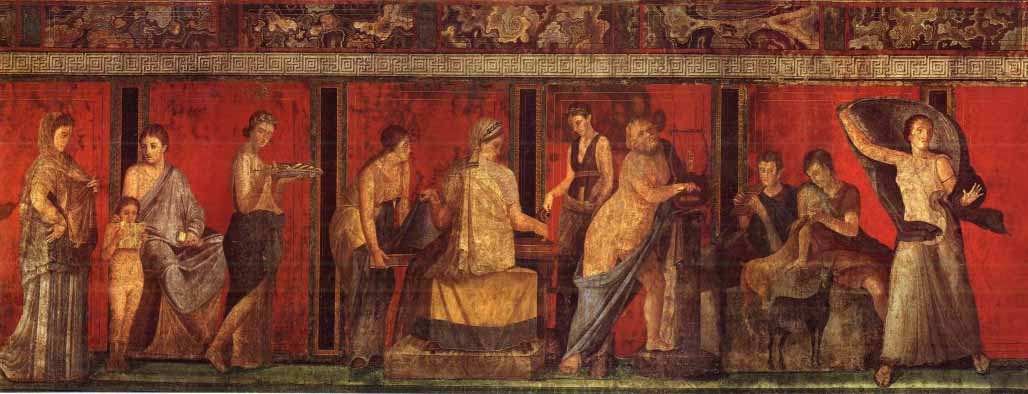
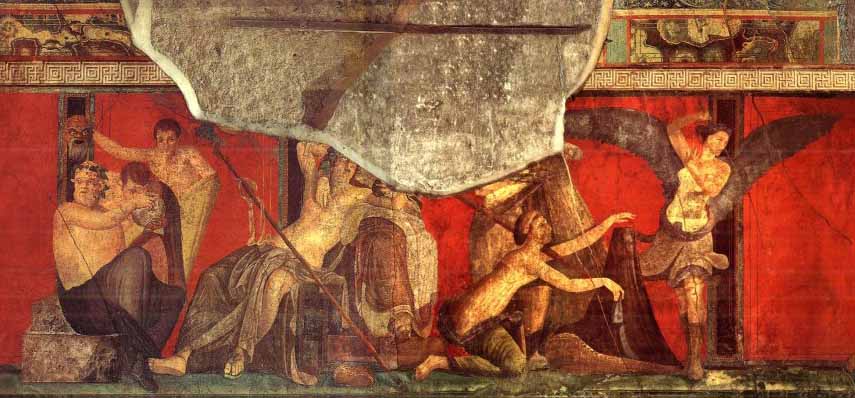
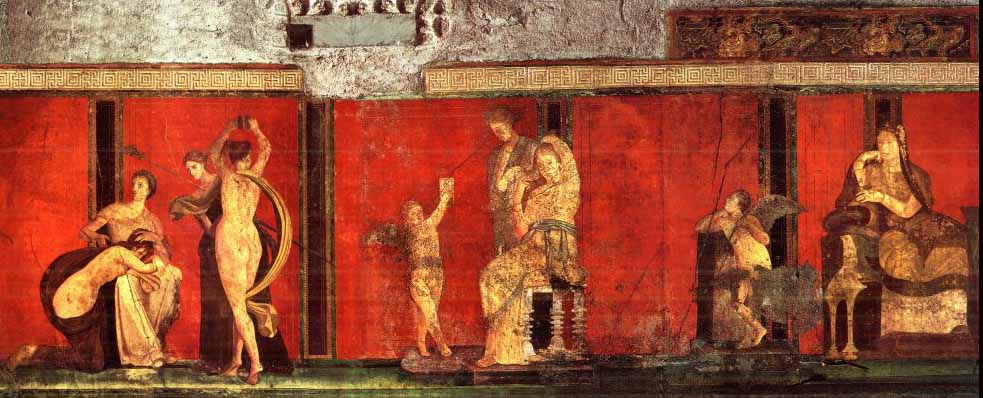
The panels only concern themselves therefore with the advancement of the initiate, what they don't do is reveal the actual mystery, at the central position one simply sees a representation of Dionysos and Ariadne his consort.
The question then is what terrible truths have been revealed, to cause this sudden appearance of ignorance and her efforts to suppress what has been revealed..
To consider this one requires understanding of the greater context of the cult of Dionysos and Ariadne, which was considered highly dangerous to the extent that it was suppressed by the Roman State in 186 AD
en.wikipedia.org...
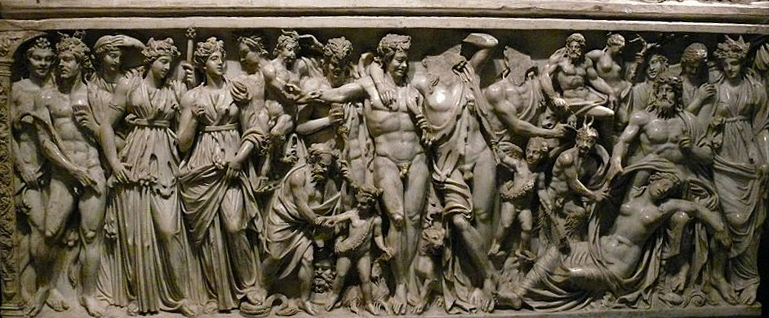
The cult involved accepting total liberality to the point of madness;
In short, all social conventions, or masks, were shed, and their was a return to a primeval state of being, in which no boundaries between gender, age, species, were recognised...In Vino Veritas..all seen as One without critical distinctions, liberal relativism.
It's also the case that no boundary is seen between this world and the Underworld, between life and death, and that both should be embraced as equal.
The Cult then stood in direct opposition to principles of Order, Reason, Judgement, which the Underworld figurehead revealed, his self evident truths.
It's interesting to see the re-emergence of the cult in the period leading up to the Neo-Classical Period and afterward;
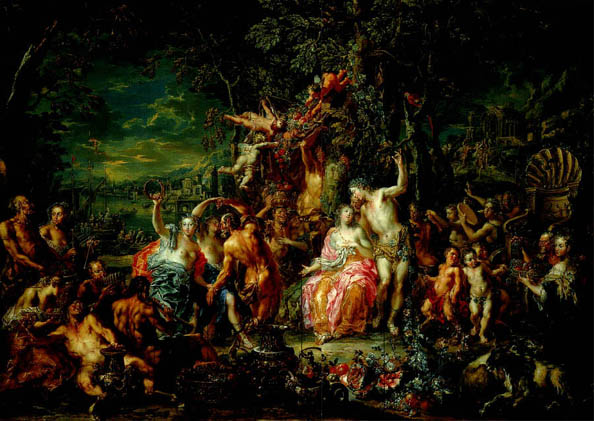
Interpretations range from the dark and sinister exotic, toward acceptance and delight;
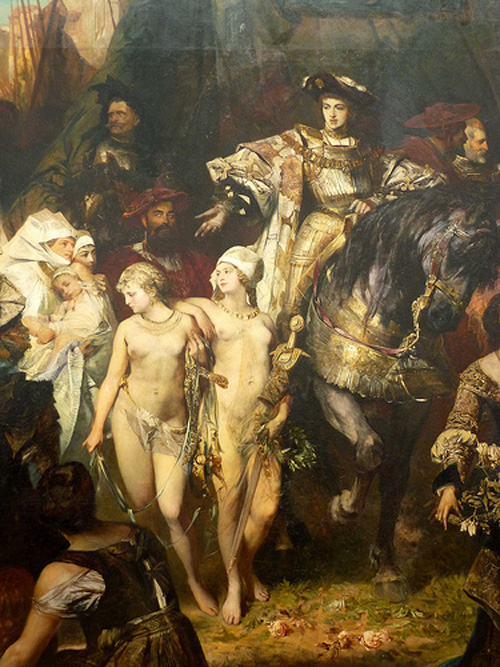
From paintings were Ariadne seems to have misgivings about her partaking in the madness, to her being the enthusiatic cheer leader;
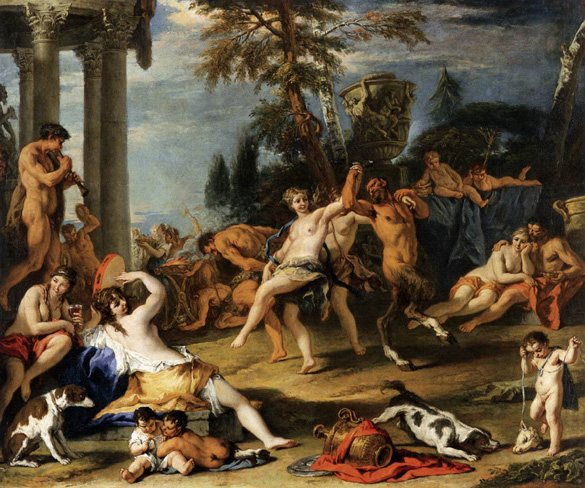
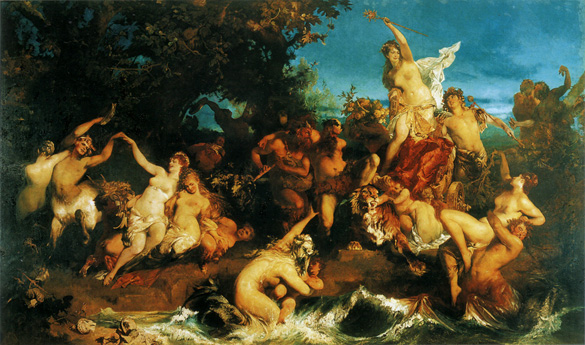
These changes in attitude of course reflect the changes in attitude of the period, increasing affluence of certain classes and decadence;
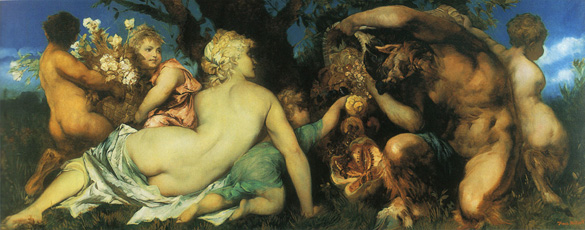
The question that remains to be asked i guess is did Ignorance have a point...???...she is a Goddess afterall.
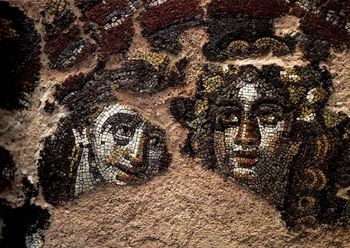
The Mysteries of Dionysos at Pompeii

This point is supported by the occurrence of a winged female in other depictions of the unveiling of the Dionysiac sacra , in which at the moment of revelation of the sacra she is turning away or even running away, and making a defensive gesture with her left hand (and it appears that the crouching woman revealing the sacra may be trying to restrain her). Now we notice that the winged female in our fresco too is making the same defensive gesture with the left hand towards the sacra. ....Agnoia because Ignorance would be put to flight by the revelation. Both these deities might be regarded as embodying the initiand's emotion lust before the sacra are revealed to her. In most pictures of the revelation the sacra have been revealed; our fresco, on the other hand, depicts the moment just before revelation. Ignorance is still in command. The candidature of Agnoia (Ignorance) has been made even more plausible by further iconographical parallels adduced by Karl Lehmann
On a fourth-century AD mosaic in Algeria a female makes towards the revelation of the Dionysiac sacra a defensive gesture reminiscent of those we have already seen, and very similar to the gesture made by another female in a second-century AD tomb-painting from Hermoupolis in Egypt (Plate 8 (d)). This latter female appears to be urging Oedipus to kill his father Laios; and the letters above her head identify her as AGNOlA, Ignorance.
Agnoia is the deity who speaks the prologue of Menander's Perikeiromene. Lehmann's identification of her with the winged flagellator of the fresco has so far as I know been neither accepted nor refuted. But consider how appropriate she is here. Firstly, she is winged: when all is suddenly revealed, Ignorance is just as suddenly nowhere: she has taken flight. Secondly, being Ignorance, she must reject knowledge of the sacra. Thirdly, she tortures the initiand. The ignorance of the initiand, just before the final moment of revelation, her fear and trembling, are regarded as an ordeal.
The ten panel sequence as described in the paper begins with the preperation of the initiate through to the ordeal of the revelation and then after the climactic panel her denial of ignorance, ecstatic embrace of the revealed truths and readjustment back into society;



The panels only concern themselves therefore with the advancement of the initiate, what they don't do is reveal the actual mystery, at the central position one simply sees a representation of Dionysos and Ariadne his consort.
The question then is what terrible truths have been revealed, to cause this sudden appearance of ignorance and her efforts to suppress what has been revealed..
To consider this one requires understanding of the greater context of the cult of Dionysos and Ariadne, which was considered highly dangerous to the extent that it was suppressed by the Roman State in 186 AD
The evolution of Dionysianism continued in the Roman Empire with the Bacchic Mysteries (as they were known in Italy after their arrival in 200 BC). Dionysus merged with the local fertility god Liber (whose consort, Libera, inspired the Statue of Liberty). The Roman Bacchic cult emphasised sexuality, inventing terrifying ordeals for its Mystery initiation. It was this aspect which caused the cult to be banned by Roman authorities in 186 BC, for sexual abuse and other criminal activities (including murder). Whether these charges were true is unknown; there may have been individual cases of corruption but there is no evidence of widespread abuse. Scholarly opinion is that these were trumped-up charges levelled against a cult perceived as a danger to the state. The Roman Senate sought to ban Dionysian rites throughout the Empire, restricting their gatherings to a handful of people under special license in Rome. However, this only succeeded in pushing the cult underground.
en.wikipedia.org...

The cult involved accepting total liberality to the point of madness;
n contrast with the daytime festivities of the Athenian Dionysia were the biennial nocturnal rites of the Tristeria, held on Mount Parnassus in winter. These celebrated the emergence of Dionysus from the underworld, with orgies (orgia) in the mountains. The first day was presided over by the Maenads in their state of Mainomenos (madness), during which animals—and perhaps humans—were hunted, torn apart with bare hands and eaten raw. This was the Sparagmos, once associated with goat sacrifice and marking the harvest (and trampling) of the vine. The second day saw the Bacchic nymphs in their Thyiadic (or raving) state. Although still orgiastic, this was a more sensual and benign bacchanal (assisted by satyrs). Mythographers claim that the Maenads (or wild women) resisted the Bacchic urge and were driven mad, while the Thyiades (or ravers) accepted the Dionysian ecstasy and kept their sanity.
In short, all social conventions, or masks, were shed, and their was a return to a primeval state of being, in which no boundaries between gender, age, species, were recognised...In Vino Veritas..all seen as One without critical distinctions, liberal relativism.
It's also the case that no boundary is seen between this world and the Underworld, between life and death, and that both should be embraced as equal.
The Cult then stood in direct opposition to principles of Order, Reason, Judgement, which the Underworld figurehead revealed, his self evident truths.
It's interesting to see the re-emergence of the cult in the period leading up to the Neo-Classical Period and afterward;

Interpretations range from the dark and sinister exotic, toward acceptance and delight;

From paintings were Ariadne seems to have misgivings about her partaking in the madness, to her being the enthusiatic cheer leader;


These changes in attitude of course reflect the changes in attitude of the period, increasing affluence of certain classes and decadence;

The question that remains to be asked i guess is did Ignorance have a point...???...she is a Goddess afterall.

edit on 24-4-2013 by Kantzveldt because: (no reason given)
reply to post by Kantzveldt
I am deeply fond of Dionysus, and enjoyed your thread and presentation immensely. He is a much misunderstood character, and has suffered more that his fair share of mis-cast aspertions and the source of the majority of those can be laid at the feet of Euripides, who served his patrons well.
Good thread, well done
I am deeply fond of Dionysus, and enjoyed your thread and presentation immensely. He is a much misunderstood character, and has suffered more that his fair share of mis-cast aspertions and the source of the majority of those can be laid at the feet of Euripides, who served his patrons well.
Good thread, well done
reply to post by Kantzveldt
Discordians honor Eris and Chaos, which seem to be the same type of concept. Disorder, when seen as a force in itself, can shake the mind out of its usual ruts (literally ruts, as the things we do and people we see create brain connections which continue to draw us to those situations). When the familiar becomes unfamiliar, the brain is forced to learn. Which is why our vacations stay with us very strongly, and those moments of "unusual" are remembered for decades. A good practice when done well.
The paintings are beautiful, as are your thought and concept flow. Nice work. I hope the Pompeii artist near the start of the OP was paid well (or maybe actually lived in the home).
Discordians honor Eris and Chaos, which seem to be the same type of concept. Disorder, when seen as a force in itself, can shake the mind out of its usual ruts (literally ruts, as the things we do and people we see create brain connections which continue to draw us to those situations). When the familiar becomes unfamiliar, the brain is forced to learn. Which is why our vacations stay with us very strongly, and those moments of "unusual" are remembered for decades. A good practice when done well.
The paintings are beautiful, as are your thought and concept flow. Nice work. I hope the Pompeii artist near the start of the OP was paid well (or maybe actually lived in the home).
reply to post by KilgoreTrout
I guess Euripedes favoured sober intellectualism over drunken genius but i'm sure there's something to be said for both.
I guess Euripedes favoured sober intellectualism over drunken genius but i'm sure there's something to be said for both.
reply to post by Aleister
There was a statue of Livia, wife of Augustus found in the villa, it's possible the villa belonged to her, it is very large and elaborate, she may even have been the initiate seen illustrated.
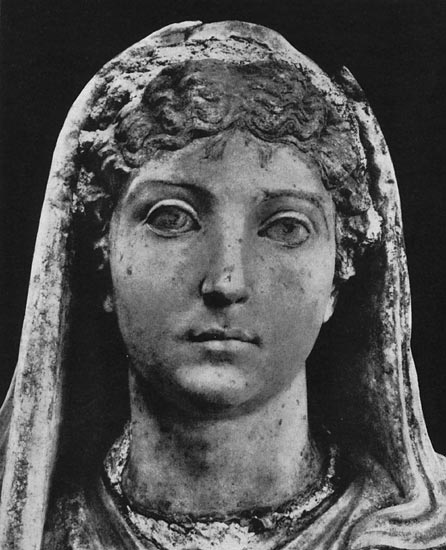
So then yes there is the encounter with the 'discordant', but then the return to normal life and place within society, a holiday of sorts as you suggest.
In the Neo-Classical representations the Bacchanal are often seen taking place before Herm stones, which can be covered over, this is the Hermetic tradition of way markers within the wilderness, a network in communication, the cult of Dionysos was reconstructed within the Hermetic framework..an indulgence of the wealthy and powerful
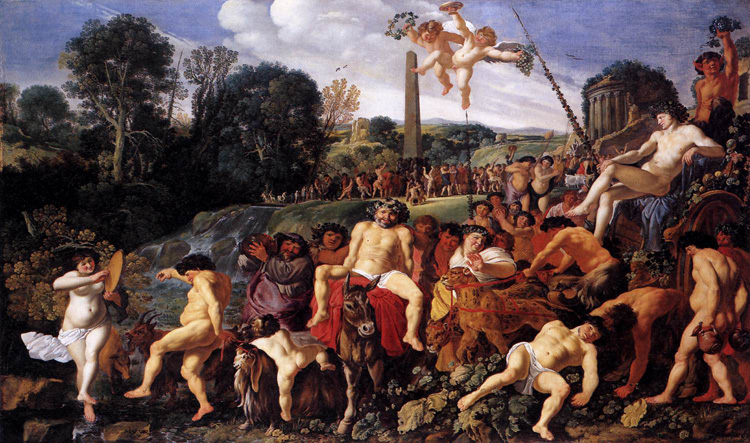
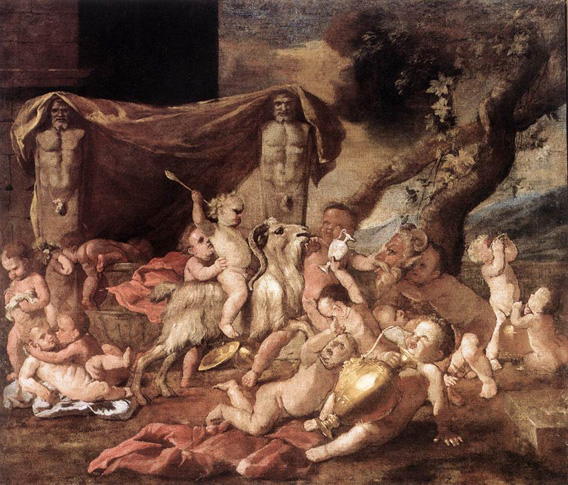
Of course this led to rumours of 'Satanic Cults', goat worship, in reality it was the cult of Dionysos, and an interpretation of Christ as the true and living vine...
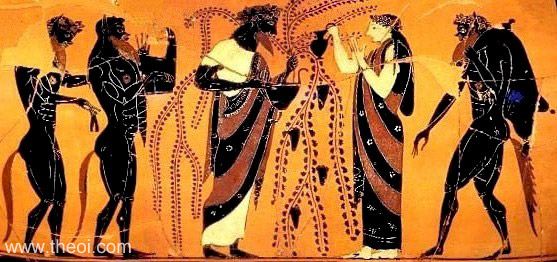
There was a statue of Livia, wife of Augustus found in the villa, it's possible the villa belonged to her, it is very large and elaborate, she may even have been the initiate seen illustrated.

So then yes there is the encounter with the 'discordant', but then the return to normal life and place within society, a holiday of sorts as you suggest.
In the Neo-Classical representations the Bacchanal are often seen taking place before Herm stones, which can be covered over, this is the Hermetic tradition of way markers within the wilderness, a network in communication, the cult of Dionysos was reconstructed within the Hermetic framework..an indulgence of the wealthy and powerful


Of course this led to rumours of 'Satanic Cults', goat worship, in reality it was the cult of Dionysos, and an interpretation of Christ as the true and living vine...

edit on 25-4-2013 by Kantzveldt because: (no reason given)
reply to post by Kantzveldt
Euripides?
no, they were like that when i found them!
i'll get my coat
SnF, splendid OP
Euripides?
no, they were like that when i found them!
i'll get my coat
SnF, splendid OP
Originally posted by skalla
reply to post by Kantzveldt
Euripides?
no, they were like that when i found them!
i'll get my coat
SnF, splendid OP
Seconded...
For all non-classical-Greek scholars, "Euripides" roughly translates as "You rip at these?"
And yes, they were like that when he found them.
I have my coat....
reply to post by Theflyingweldsman
stop trying to Confucius
i really am going now, sorry for temporary classics based humour derailment
stop trying to Confucius
i really am going now, sorry for temporary classics based humour derailment
reply to post by Kantzveldt
I am again struck by the beauty of the paintings and sculptures you picture, the brightness and energy is so much better than what passes for art now. Decadence has its place (my place!), and I wonder if the people actually frolicked around naked in fields and under trees like that. Good times.
Livia seems to be in her teens or early twenties when the sculpture of her was made. She and/or someone else had great taste in artwork, and hired the best. I can't help but think of another thread that resufaced yesterday about modern art, with splotches of color that a first grader could do (a talented first grader, but a first grader nonetheless). In short, Wine, women, and song! (and a lack of the later "Christian values" which sat on artists backs for many hundreds of years).
I am again struck by the beauty of the paintings and sculptures you picture, the brightness and energy is so much better than what passes for art now. Decadence has its place (my place!), and I wonder if the people actually frolicked around naked in fields and under trees like that. Good times.
Livia seems to be in her teens or early twenties when the sculpture of her was made. She and/or someone else had great taste in artwork, and hired the best. I can't help but think of another thread that resufaced yesterday about modern art, with splotches of color that a first grader could do (a talented first grader, but a first grader nonetheless). In short, Wine, women, and song! (and a lack of the later "Christian values" which sat on artists backs for many hundreds of years).
Originally posted by Kantzveldt
reply to post by KilgoreTrout
I guess Euripedes favoured sober intellectualism over drunken genius but i'm sure there's something to be said for both.
That is not necessarily it, our perception of the Dionysus Mysteries is clouded by Euripides' plays, a perception that was built upon during the Enlightenment when those texts were more widely studied and distributed. Dionysus was looked upon from a different morality, still is to an extent, that did not understand the role of fertility rites and rituals in bringing people together to do the hard work necessary to bring in the crops and process the produce. In Greece and Rome, the ruling elites, much like that of the Enlightenment period, enforced an unnatural morality upon the working classes, the people were no longer helping each other out, joining forces, they were employees, or rather slaves. They did as they were told, not because it was good to help your neighbours and have a party and get jiggy at the end of the labours. The elites expected one thing from their workers, and yet led highly 'debauched' lives themselves. While many of the Mystery religions were banned for the common people, they were continued, to some degree, behind the closed doors of the elite families homes, except, they just took the fun bits, without the meaning and purpose behind it.
new topics
-
Just learned a really helpful trick for internet searches
Computer Help: 4 hours ago -
Not off to a good start
General Chit Chat: 6 hours ago
top topics
-
If they can see...they can read!!
Rant: 13 hours ago, 7 flags -
Not off to a good start
General Chit Chat: 6 hours ago, 5 flags -
Just learned a really helpful trick for internet searches
Computer Help: 4 hours ago, 3 flags
active topics
-
Tesla Cybertruck Explodes in Front of Trump Hotel in Las Vegas
Mainstream News • 80 • : xuenchen -
Ukraine halts transit of Russian gas to Europe after a prewar deal expired
Political Conspiracies • 104 • : crayzeed -
Simulation theory and have we reset before like a game?
Conspiracies in Religions • 41 • : Xtrozero -
Not off to a good start
General Chit Chat • 11 • : charlest2 -
How we've changed in 100 years
Ancient & Lost Civilizations • 32 • : Xtrozero -
If they can see...they can read!!
Rant • 20 • : bluesman023 -
The C.D.C. Says There Was NO INFLUENZA Worth Reporting for the 2020-2021 Flu Season.
Diseases and Pandemics • 90 • : AlexandrosOMegas -
Maybe they didn't get away with it: The Lincoln-Kennedy assassination parallels. 7 sentences long.
History • 11 • : BernnieJGato -
Vehicle Strikes people in New Orleans
Mainstream News • 257 • : Xtrozero -
Post A Funny (T&C Friendly) Pic Part IV: The LOL awakens!
General Chit Chat • 7977 • : baddmove
17
